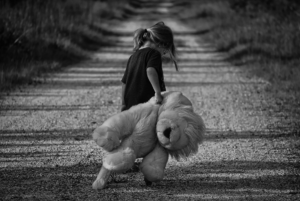Why You Fear Abandonment
If our caregivers were inconsistent, we’ll be more likely to distrust other peoples’ feeling for us and fear abandonment…
What is Attachment Theory?
Presented here is my personal understanding of abandonment and attachment theory which may not be an accurate representation of what other scholars think. Theories should be functional, they either help us to explain and predict the inner and outer world or they don’t, and so I want you to consider these ideas not in terms of being ultimately true or false, but rather ask yourself, does this help me understand myself and others better? Does it lead to a forgiving and compassionate perspective?
Attachment theory claims that how our caregivers treated us when we were young explains the relative level of security or insecurity we feel in our relationships. As children, we’re completely dependent on our caregivers for everything. We need them to provide us with food, with shelter, to protect and teach us. Unlike many animals, we can’t survive on instinct alone. It is a caregivers love and compassion that motivates them to take care of their child, so it’s reasonable to say that a child needs to be loved. Without that love, they will die.
An infant can’t communicate their needs in words and so the caregiver needs to have an intuitive understanding of the childs needs, knowing when they’re hungry, thirty, tired, scared and so forth, and to act appropriately.
If the caregiver’s able to intuit the child’s needs and consistently provide for them in a timely manner, the child learns to feel secure. They learn to trust that their caregivers will be there when they need them. If the caregiver also intuits when to give the the child space and explore things on their own, it helps them grow in confidence they can do things by themselves. For the child, these experiences translate into a tendency, as adults, to be open and comfortable with intimacy, the giving and receiving of affection, and a confidence and comfort in spending time alone.
If the caregiver is overly worried and fearful of their child doing things by themselves, if they’re always doing everything for them, or anxiously telling them to be careful or that they might get hurt, it might be more difficult for the child to develop confidence and independence. They may become uncertain of themselves and need a lot of encouragement to take risks.
It’s impossible for a caregiver to do the right thing all the time and if the parent or caregiver is very inconsistent and not attuned to the child’s needs, the child may lose confidence in others to provide for them, and this manifests as separation anxiety, which is in other words, a fear of abandonment.
Of course our relative sense of security or insecurity can be influenced by future events, and can be affected by the relative security or insecurity of the other person feels.
The following examples aren’t meant to be taken literally, but as food for thought in considering the kind of messages we received and how these contributed to the way we are in relationships today. The good news is that since these behaviours have been learned, they can be unlearned.
Secure Attachment Style
If our caregiver is consistent and attuned to our needs, we may grow up to feel relatively confident and secure in our relationships, generally trusting that other people care for us, and relatively confident we’ll be fine on our own. We recognise healthy and unhealthy relationships for what they are. We’re more likely to enter relationships that are interdependent, as opposed to codependent, where we give each other space, and also help each other from a place of joy, as opposed to need. We support and encourage each other without seeking each other’s approval or validation.
Insecure Anxious Attachment Style
If our caregivers were inconsistent in providing for our needs, we’ll be more likely to distrust other peoples’ feeling for us, and more likely to fear abandonment. That’s not to say we always fear the persons “leaving us”, as the fear of abandonment may manifest, for example, as a fear of being misunderstood.
With an insecure attachment style, we’re less capable of recognising the difference between healthy and unhealthy relationships and may regularly doubt people’s feelings for us. This doubt may manifest in our seeking implicit or explicit validation. We may read a lot of meaning into the things our partner does, or doesn’t do, as indicating whether they care for us or not. We may also seek our partners approval in the form of affection, compliments and recognition, and either get angry with them or feel bad about ourselves when we don’t get the validation we wanted. We’re more likely to feel hurt by perceived criticism; feeling offended or discouraged, for example, when anyone expresses disapproval of our behaviour.
The anxious person has a tendency to “move toward” or “reach out” to the other person, because they didn’t get the intimacy they needed as a child. They rarely feel as close to other people as they want to be. It’s likely they appear more emotional and needy than the person who’s insecure avoidant.
Insecure Avoidant Attachment Style
If our caregivers were inconsistent in providing for our needs, we’ll be more likely to distrust other peoples’ feeling for us, and more likely to fear abandonment. That’s not to say we always fear the persons “leaving us”, as the fear of abandonment may manifest, for example, as a fear of being misunderstood.
With an insecure attachment style, we’re less capable of recognising the difference between healthy and unhealthy relationships and may regularly doubt people’s feelings for us. This doubt may manifest in our seeking implicit or explicit validation. We may read a lot of meaning into the things our partner does, or doesn’t do, as indicating whether they care for us or not. We may also seek our partners approval in the form of affection, compliments and recognition, and either get angry with them or feel bad about ourselves when we don’t get the validation we wanted. We’re more likely to feel hurt by perceived criticism; feeling offended or discouraged, for example, when anyone expresses disapproval of our behaviour.
The anxious person has a tendency to “move toward” or “reach out” to the other person, because they didn’t get the intimacy they needed as a child. They rarely feel as close to other people as they want to be. It’s likely they appear more emotional and needy than the person who’s insecure avoidant.
Co-Dependent Relationships
A secure person has a well developed sense of self-acceptance and will probably choose a partner who sees, hears, understands and accepts them. A secure person recognises healthy compatibility and doesn’t pursue, or, can easily move on from relationships that are dysfunctional. They can do this without feeling hurt, without taking it personally and without blaming the other person for it not working out.
The insecure person on the other hand, has a tendency to choose partners who aren’t very accepting, attentive or understanding. They tend to stay in relationships that are dysfunctional, wishing things were different, and often trying to win their partners love and approval. They may alternate between blaming themselves and blaming the other person for not getting their needs met. Everything is seen as being very personal. There’s either “something wrong with me”, or “something wrong with them”.
A relationship between two insecure people can become co-dependent. These relationships are often characterised by separation anxiety, jealousy, and ultimatums in which the end of the relationship is threatened in hopes of manipulating the other persons behaviour. Both people find themselves compromising their real desires in order to avoid the other’s disapproval. Both people over value the relationship and overestimate its power to fulfil their needs.
In relationships like this, no one’s really satisfied as there is a lack of understanding and acceptance of each other and themselves, and more time spent is feeling conflicted or disconnected than in harmony. It may seem as if the same problems keep coming up again and again.
Insecure people are more more likely to mistake attachment for love. We may want someone to need us, to be attached to us, because it makes us feel more secure. We think if they’re attached to us, they’re less likely to abandon us. This can cause us to interpret their feeling bad when we feel bad as sign they love us, and they’re not feeling bad when we feel bad as a sign they do not love us. We might think their being jealous is a sign they love us, and similarly think our jealousy is a sign we love them. In reality, these things are just a sign of our insecurity.
We’re generally attracted to what’s familiar to us, and that is why relationships often form between someone who’s insecure anxious, and someone who’s insecure avoidant. These people are attracted to each other because the anxious person had a distant parent, and is familiar with “chasing” while the avoidant person had an overly attentive parent and is familiar with “running”. Their energy and behaviour seem familiar to each other. A child isn’t born with an understanding or a blueprint of a healthy relationship. They learn about relationship through their parents and by observing the relationships around them. If for example, your parents had a dysfunctional relationship and stayed together for a long time, this may model to you that it’s normal to engage in that kind of interaction.
With that being said, many people have both anxious and avoidant tendencies. Which appears may depend the relative level of security or insecurity the other person feels. We may find if our partner is more insecure than us, that we become the avoidant one, irritated by their doubt and need for validation, and wanting time away from them. If we enter a relationship where we’re more insecure, we may find ourselves doubting their feelings and seeking more validation.
Essentially, we want our partner to love us in the way our parents didn’t. More broadly speaking, all we really want is to be loved and accepted the way we are. What we really want, is to know that no matter what we think, feel, say or do, that the other person isn’t going to abandon us. That they’re not judge us. That they’re not going to punish us for being ourselves. We don’t want them to become cold or distant.
Of course, few people are realistically capable of offering this kind of unconditional love to others, let alone themselves. Meditation is about learning to offer that loving acceptance to ourselves. Through meditation we can fulfil our own needs, and in doing so the neediness and insecurity we feel in our relationships will vanish, but I will describe how this works in another article.
Insecure Disorganised Attachment Style
One of the minds principle functions is to predict the world around us for the purpose of securing our safety and wellbeing. If our caregiver is inconsistent and unpredictable, sometimes attentive and sometimes not, and if their reaction to our needs was sometimes met with love and sometimes met with anger we may become distant and non-responsive, since it’s very difficult, if not impossible, for us to predict what reaction we’re going to get from them.
For some people, growing up in this environment produces a strong intuition, or ability to read others, the reason for this being, that from an early age they had to read others well in order to better predict their behaviour. They had to do this because they did not feel safe.
People with insecure disorganised attachment may find they have less interest in relationships than other people do. They may value their material, mental and emotional independence more highly that others. They might also be hyper-sensitive to inconsistency and when they notice what they think are signs of inconsistency, their positive feelings and attraction for the other person may disappear at once, and they find they lose all interest in the relationship. It may consequently take them a long time to trust other people, or to even feel like intimacy’s worth the effort.
The Signs of Detachment
While non-attachment is the natural result of recognising we are whole and complete as we are, right here, right now, and that we don’t need others love or approval to be happy… detachment, as I use the word, is the fear of attachment. It is the fear we feel when we begin to recognise a craving or sensitivity to the other person’s feelings for us. We can become detached at any age. It is often the result of feeling betrayed or disillusioned by a huge disappointment, such as someone breaking trust while we were dependent on them. It’s worth noting that if someone breaks our trust, and we were not depending on them for our sense of security, that we do not feel as hurt or become detached.
Being detached may manifest as feeling that “relationships aren’t worth it”. If the pain is deeper, it can manifest as numbness. We may genuinely feel that we have no interest in relationships and think we have no desire to be loved or accepted by others. Of course some people are happy by themselves but to not want a relationship, to be turned off by the idea, or repelled by the notion of having a romantic partner or close friends is a sign of detachment. When we’re unattached, we’re present, and don’t make decisions about our future, we’re open to possibilities without craving or rejecting them. When we’re detached, we’ve made a decision about the future.
For some people, growing up in this environment produces a strong intuition, or ability to read others, the reason for this being, that from an early age they had to read others well in order to better predict their behaviour. They had to do this because they did not feel safe.
People with insecure disorganised attachment may find they have less interest in relationships than other people do. They may value their material, mental and emotional independence more highly that others. They might also be hyper-sensitive to inconsistency and when they notice what they think are signs of inconsistency, their positive feelings and attraction for the other person may disappear at once, and they find they lose all interest in the relationship. It may consequently take them a long time to trust other people, or to even feel like intimacy’s worth the effort.
Self-Sabotage and Manipulation
Wherever there’s attachment, there is fear and wherever there is fear, there is the potential for us to think, say and do things which are selfish, or which may be aimed at hurting other people. This happens for two reasons. One, if we know, consciously or subconsciously that the other person is attached to us, then we know we can manipulate them with our negativity. We do this in an attempt to get what we want from them, like sex or material support. We may also do this to get them to stop doing things that trigger insecurity in us, such as asking them not to see someone because it makes us jealous rather than examine why we’re insecure.
We may also hurt other people in a process that is referred to as self-sabotage. We hurt them to test the boundaries and extent of their love. Will they stick around if I do this, or this? One reason we engage in self-sabotage is because we fear uncertainty. We fear abandonment so much that we’d rather be without, than to live with the anxiety brought on my doubt.
Another reason we engage in self-sabotage is because things are going well and this is incompatible with the negative beliefs we have about ourself, about others, or our life, and subconsciously we’re looking for proof of our unworthiness.
Don't Blame Your Parents
Our parents had parents who weren’t perfect either. We can’t blame our parents for our insecurities since they did their best. It’s important to consider too that there may have been events in our caregivers life that put them under stress or otherwise distracted them. This can have an impact, not only on how much time they have for their child, but on the kind of emotions and behaviours they are modelling. Things like war, divorce, poverty, having to work a lot, and serious illness can all affect a caregivers relationship with their child.
The trouble is a child has no way of comprehending what their caregiver’s going through. It’s no consolation to the child that their parents wanted to be there, but couldn’t be, as all they know is that they weren’t. As children we can’t reason that our parents have their own maladaptive mental and emotional patterns, acquired from their own lives, but we can try to understand that now and forgive them.
Try it For Yourself
I don’t think it’s necessary for us to remember our childhood in detail to make use of this information, since the present moment tells us everything we need to know. You can begin an exploration of the way you are in relationships by asking simple questions like:
- Do I worry about whether or not my partner loves me or finds me attractive?
- Do I read into my partners behaviours as signs they love or do not love me?
- Do I seek explicit validation from my partner about how they feel about me?
- Do I interpret my partner being needy or jealous as a sign they love me?
- Do I think of my own neediness and jealousy is a sign I love my partner?
- Do I ever use my feeling hurt or angry to manipulate my partner into changing their behaviour?
- Do I ever act in a passive aggressive way, such as cold and distant to show I’m bothered?
- Do I feel an unusually intense fear at the thought of the relationship ending?
Counselling and meditation can change your attachment style, leading to secure relationships.
Recent Posts

How To Set Achievable Goals
This guide explains how the do’s and don’ts of setting goals. With this short tutorial, you’ll be accomplishing one goal

Stop Blaming, Avoiding, Distracting: Explore
In order to cope with negative thoughts and emotions we tend to respond with blame, avoidance and distraction, when… Ways

Why You Fear Abandonment
If our caregivers were inconsistent, we’ll be more likely to distrust other peoples’ feeling for us and fear abandonment… What

How to Heal Your Core Wounds
Core wounds are feeling of hurt that takes the form of negative beliefs, like “I’m not good enough”… Primary and

Healing Your Inner Child
As children we don’t recognise that our parents have their own issues which have nothing to do with us… A
